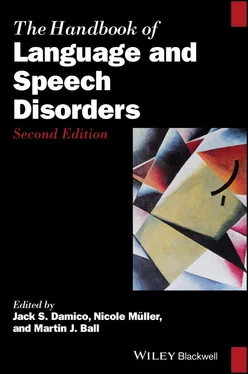Clinically, intelligibility measures provide an important metric that can be used for treatment decision‐making. Intelligibility measures are often used as a basis of comparison for documenting and monitoring change in speech performance (Yorkston, Beukelman, Strand, & Bell, 1999), as an index of severity of the speech disorder (Weismer & Martin, 1992), and as an indicator of functional ability (or disability) relative to “normal” performance (Yorkston et al., 1999). Critical clinical concerns such as justifying treatment for third‐party payers, and deciding whether or not to discontinue intervention, sometimes may be made on the basis of intelligibility measures.
4.2 Intelligibility Defined
Intelligibility is a complex and multifaceted construct that is dynamic in nature. It has been defined as the extent to which an acoustic signal, generated by a speaker, can be correctly recovered by a listener (Kent, Kent, et al., 1989; Kent, Weismer, Kent, & Rosenbek, 1989; Yorkston & Beukelman, 1980). Intelligibility is a dyadic construct that is not solely attributable to a speaker or to a listener. Rather, it is a product of the joint efforts of the speaker (who produces the signal) and the listener (who interprets the signal) as communication partners . To be intelligible, speech does not need to be perfect or even “normal.” In fact, productions may be characterized by a range of different errors and still be readily recoverable to listeners. The key issue in intelligibility is whether listeners are able to map acoustic cues onto the intended linguistic representations in spite of any deviant production patterns.
Intelligibility is influenced by a host of variables related to the speaker and his or her impairment(s), the listener and his or her ability to make sense of a distorted speech signal, and contextual factors such as the communicative environment, and shared knowledge between the speaker and the listener. Studies have shown that intelligibility can be markedly affected when different variables are manipulated. Examples include the length and nature of speech being produced (single words, individual sentences, narrative discourse, conversational discourse) (Hustad, Mahr, & Rathouz, 2020; Miller, Heise, & Lichten, 1951), semantic predictability of messages (Kent, Miolo, & Bloedel, 1994), availability of visual information (Borrie, 2015; Hustad & Cahill, 2003; Hustad, Dardis, & McCourt, 2007), and listener familiarity with the speaker (Borrie et al., 2012; Liss, Spitzer, Caviness, & Adler, 2002), to name but a few. Because so many variables influence intelligibility, no one measure can accurately and adequately provide a complete index of it. Kent and colleagues have suggested that “a particular talker has a range of intelligibility potentials, depending on listener familiarity, nature of the linguistic message, physical setting, motivation, effort level, and so on” (Kent et al., 1994, p. 81). Thus, any given measure of intelligibility is best considered a snapshot of performance under a specific set of circumstances. An intelligibility estimate must be interpreted cautiously and within the context it was obtained.
Within the World Health Organization’s International Classification of Functioning, Disability, and Health (ICF‐2), intelligibility has been regarded as an index of a person’s ability to engage in the activity of speaking (Dykstra, Hakel, & Adams, 2007). Intelligibility is influenced by body structures and functions, particularly the speech subsystems of articulation, resonance, phonation, and respiration, and their constituent components. However, intelligibility is separate from speech subsystem structures and functions because intelligibility is a product of the subsystems working together as a collective whole to produce speech. Further, intelligibility requires the contribution of a listener. It is also influenced by contextual factors. A person’s ability to participate in his or her life situations (the participation level of the ICF‐2) is impacted by intelligibility as well as the broader notion of comprehensibility.
4.3 Measurement of Intelligibility
Intelligibility is challenging to measure, in part because of its complexity. A considerable body of research has demonstrated that there are many variables that may influence intelligibility, as noted above. Operationally, there are two main approaches to measuring intelligibility: objective measures and subjective measures.
4.3.1 Objective Measures of Intelligibility
Objective measures of intelligibility can be obtained and scored in numerous ways, but the primary commonality is that a specific speech sample is directly analyzed to yield a quantitative score. Objective measures often involve transcription of speech, using traditional orthography, broad phonetic transcription, narrow phonetic transcription, or forced‐choice recognition of target items. These approaches typically yield a percentage of items identified correctly relative to the targets that the speaker intended to produce (Tikofsky & Tikofsky, 1964; Yorkston & Beukelman, 1978, 1980). Objective measures have been considered the “gold standard” for measuring intelligibility clinically because quantification is straightforward: units are either correct or incorrect. However, in order to score items as correct or incorrect, targets produced by the speaker must be known so that they can be scored accordingly. For this reason, elicited words and sentences are typically used for measuring intelligibility via transcription or forced‐choice recognition approaches. Standard clinical tools such as the Sentence Intelligibility Test (SIT; Yorkston, Beukelman, & Tice, 1996), the Assessment of Intelligibility of Dysarthric Speech (Yorkston, Beukelman, & Traynor, 1984), and the Test of Children’s Speech (TOCS; Hodge & Daniels, 2007) employ this type of transcription method. Of particular note is that typically listeners are unfamiliar with the speaker and the stimulus material and are thus “naïve,” potentially representing an unfamiliar listener that a speaker may encounter in daily life. However, there are several aspects of intelligibility measurement that are less ecologically representative. For example, speakers are recorded in a quiet environment, and listening tasks also usually take place in a quiet environment, which may be unlike many speaking situations. Indeed, background noise has been shown to further reduce intelligibility for listeners transcribing dysarthric speech (Yoho & Borrie, 2018). In addition, the language produced by speakers is not spontaneously generated in elicitation or recitation tasks, thus any interactions between language formulation, language production, and speech motor variables (for the better or for the worse) may not be reflected in elicited intelligibility measures. Finally, the speaker and listener do not have the opportunity to interact, making intelligibility contrived and without a real communicative purpose.
There is a body of evidence showing that adult speakers without communication disorders entrain their speech production behaviors to one another during conversation, essentially becoming more acoustically and perceptually similar (Borrie, Barrett, Willi, & Berisha, 2019; Giles & Powesland, 1975; Pardo, 2006). These interdependent adjustments to speech production behavior occur at a seemingly unconscious level during spoken dialog and are considered to reduce the computational load of spoken language processing and improve the effectiveness and efficiency with which information is exchanged. While this is a new area of investigation for individuals with intelligibility impairment, work has begun to examine entrainment of speech behaviors in the conversations that occur between individuals with dysarthria and adults without communication disorders. Preliminary evidence suggests that, while substantially reduced relative to the entrainment that occurs between two adults without communication disorders, entrainment of some speech behaviors may transpire in conversations with this clinical population (Borrie, Barrett, Liss, & Berisha, 2020; Borrie, Lubold, & Pon‐Barry, 2015). While the link between entrainment and traditional measures of intelligibility has not yet received attention, entrainment of speech behavior, even in conversations with individuals with dysarthria, has been linked with objective measures of improved communicative efficiency.
Читать дальше












